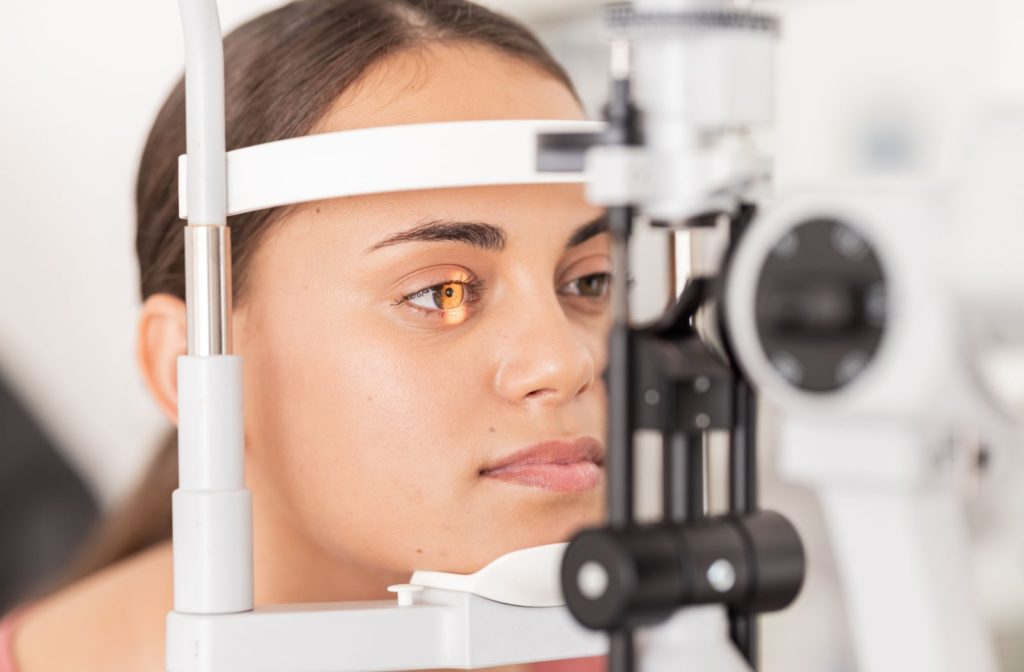Dry eye disease is a common eye condition that causes symptoms like burning sensations, redness, and watery eyes. It is often a chronic condition that occurs when your eyes do not produce enough tears or when your tears evaporate too quickly.
Meibomian gland dysfunction is a common underlying cause, but dry eye can also be caused by environmental factors like dry air and smoke. Understanding the cause of your symptoms is important for getting the right type of dry eye treatment.
Understanding Dry Eye Disease
Dry eye disease, clinically known as keratoconjunctivitis sicca but often simply called “dry eye,” is a multifactorial disorder of the tears and ocular surface that can cause symptoms of discomfort, visual issues, and tear film instability. Without treatment, dry eye disease can also damage the surface of your eyes.
This condition is common, especially among people over the age of 50 and those who spend a lot of time looking at screens. Dry eye affects a growing number of digital workers. Women are also often more likely to experience dry eye symptoms due to hormonal changes, particularly during menopause.
Dry eye disease goes beyond physical discomfort and can greatly affect your quality of life. It can make everyday activities like reading, driving, and using digital devices difficult. If left untreated, it can lead to more severe consequences for your vision and cornea health. It is important to take a proactive approach to managing this condition before your discomfort and symptoms get severe.
Symptoms of Dry Eye Disease
The effects of dry eye disease can vary from person to person, but some common symptoms include:
- Dryness
- Irritation or burning sensations in the eyes
- Redness
- Blurry vision
- Sensitivity to light
- The feeling like there is something in your eye
- Watery eyes
- Difficulty wearing contact lenses
If you experience any of these symptoms, you should schedule an eye exam. Early detection and management can prevent further discomfort and potential eye damage.
Dry Eye Causes & Risk Factors
There are multiple factors and conditions that can cause dry eyes, including:
- Age-related changes in tear production: As you age, your tear production can decrease and the composition of your tears may change, leading to dry eyes.
- Hormonal changes: Hormonal changes, such as those that occur during menopause, can affect tear production and cause dry eyes.
- Screen time: Staring at screens for extended periods of time can cause reduced blinking and increased evaporation of tears, resulting in dry eye symptoms.
- Medical conditions: Certain medical conditions can cause dry eye disease, such as diabetes, thyroid problems, and autoimmune diseases.
- Environmental factors: Many environmental factors can contribute to dry eyes, such as dry and windy climates, indoor heating, and air conditioning.
- Medications: The medications that can cause dry eyes include antihistamines, antidepressants, and medications that cause hormone changes.

Dry Eye Treatment & Management
Dry eye disease cannot be cured, but it can be managed with proper treatment. When you visit us for dry eye therapy, we may recommend 1 or more of the following treatments:
- Artificial tears: Over-the-counter artificial tears and eye drops can provide temporary relief by supplementing your natural tear production, but they should always be used with guidance from an eye doctor.
- Prescription medications: In some cases, we may prescribe medication to help reduce inflammation and increase tear production.
- Punctal plugs: These tiny silicone or collagen plugs can be inserted into your tear ducts to block drainage, helping keep tears on the surface of your eyes for longer.
- Nutritional supplements: Omega-3 fatty acids, found in supplements and foods like fish and flaxseed, may also help improve meibomian gland function and reduce dry eye symptoms.
- iLux treatment: Treatments with iLux use gentle heat and pressure to unblock clogged glands and stimulate natural tear production.
- Contact lens options: If you wear contact lenses, we may recommend switching to a different type or brand of contacts that are more suitable for dry eyes.
It’s important to consult an eye care professional before starting any dry eye treatment. We can recommend the right treatment plan for the specific cause of your symptoms. Additionally, managing underlying medical conditions and avoiding environmental triggers can also help alleviate dry eye symptoms.
Reducing Dry Eye Risks
While dry eye disease cannot always be prevented, there are steps you can take to reduce your risk and manage symptoms:
- Stay hydrated: Drinking plenty of water helps maintain moisture throughout your body, including your eyes.
- Take breaks from screen time: Extended periods of staring at a screen can cause eye strain and decrease your blink rate, leading to dry eyes. Be sure to take breaks or use the 20-20-20 rule (every 20 minutes, look at something 20 feet away for 20 seconds) to give your eyes a break.
- Wear protective eyewear: If you are exposed to dry or windy environments, consider wearing specialty eyewear like safety glasses or goggles to protect your eyes from irritants.
- Use a humidifier: Adding moisture to the air can help stop your eyes from drying out.
- Avoid irritants: Certain chemicals and allergens can trigger dry eye symptoms. If possible, try to avoid these triggers or use protective measures when exposed to them.
By incorporating these preventive strategies into your daily routine and seeking proper treatment, you can reduce the discomfort and inconvenience of dry eye disease. Remember to consult a professional for personalized advice and treatment options when your symptoms persist.
Comprehensive Dry Eye Treatment & Personal Care
Don’t let dry eyes go untreated—it’s important to seek proper treatment and support to maintain the health of your eyes. At Doctors EyeCare Grande Prairie, we are dedicated to providing personalized eye care services and treatments for various conditions, including dry eye disease.
Our team will work closely with you to create a treatment plan that addresses your specific needs. Contact us today to schedule an appointment, and let us help you maintain the health and comfort of your eyes.




